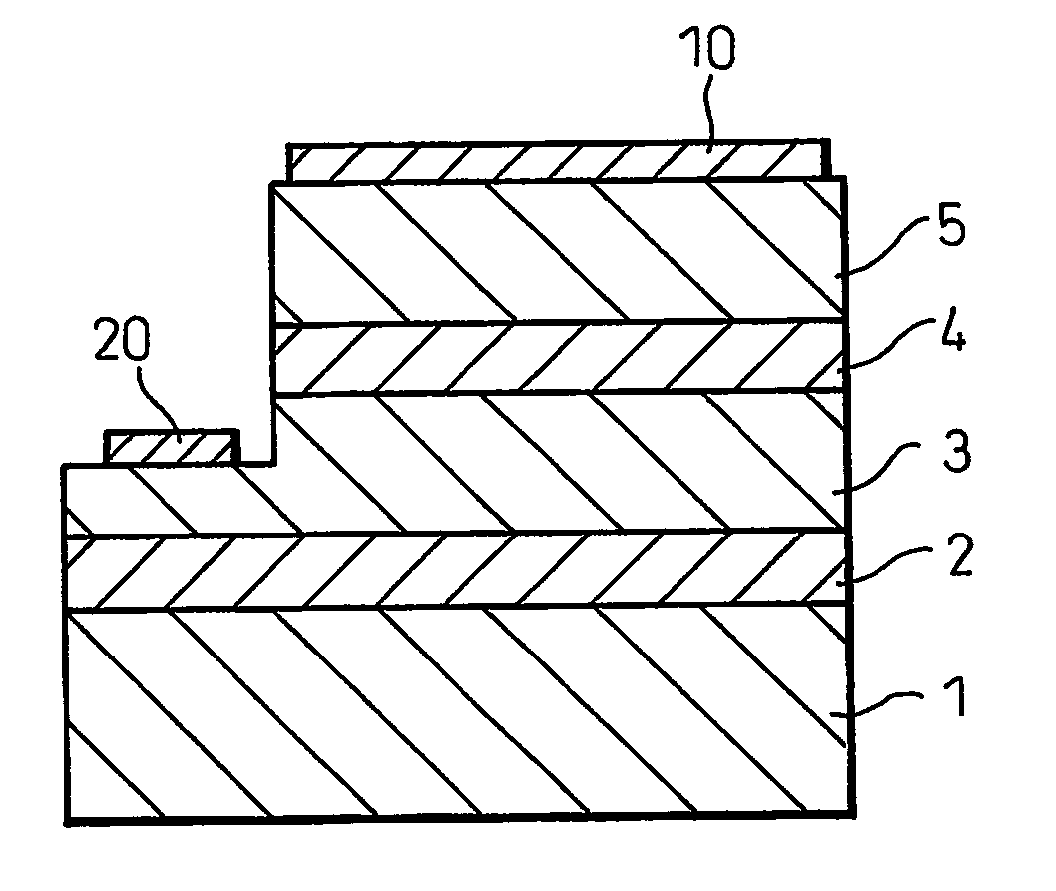Method for manufacturing p-type group iii nitride semiconductor, and group iii nitride semiconductor light-emitting device
a technology of nitride semiconductor and nitride, which is applied in the direction of semiconductor lasers, crystal growth process, polycrystalline material growth, etc., can solve the problems of reduced crystallinity, difficult formation of p-type semiconductors, and high cost, and achieves fewer steps and better productivity.
- Summary
- Abstract
- Description
- Claims
- Application Information
AI Technical Summary
Benefits of technology
Problems solved by technology
Method used
Image
Examples
example 1
[0043] In the present example, a sample was fabricated by a process in which a GaN layer was formed as a buffer layer, on a sapphire substrate using the MOCVD method, and a GaN layer doped with Mg was laminated thereon at 1100° C. Furthermore, after lamination, the supply of ammonia gas and H2 was stopped at a temperature of 1050° C., nitrogen gas was supplied thereto instead, and the product was cooled, whereby an Mg p-type dopant was put in an activated state. Details thereof are described hereinafter.
[0044] The sample with a GaN layer was fabricated using the MOCVD method in the procedure described below. First, the sapphire substrate was inserted into a quartz reactor mounted in the RF coil of an induction heating furnace. The sapphire substrate was placed on a carbon susceptor used for heating. After the substrate had been inserted, a vacuum was formed inside the reactor, the air was removed, nitrogen gas was circulated therein, and the inside of the reactor was purged. After ...
example 2
[0060] The group III nitride semiconductor light-emitting device depicted in FIG. 1 was fabricated using the p-type group III nitride semiconductor obtained by the manufacturing method of the present invention.
[0061] An n-type semiconductor layer 3, a light-emitting layer 4, and a p-type semiconductor layer 5 were grown in this order by a common vacuum MOCVD method widely known in the art via a buffer layer 2 composed of AlN on a substrate 1 composed of a sapphire c face ((0001) crystal face), and a layered structure was fabricated. An undoped GaN layer (foundation layer: layer thickness=2 μm) and a Ge-doped n-type GaN layer (n contact layer: layer thickness=2 μm, carrier concentration=1×1019 cm−3) were laminated in the same order as the n-type semiconductor layer 3. The light-emitting layer 4 had a multiple quantum structure composed of a six-layer Ge-doped GaN barrier layer (layer thickness=14.0 nm, carrier concentration=1×1018 cm−3) and a five-layer undoped In0.20Ga0.8ON well la...
example 3
[0075] A light-emitting device was fabricated in the same manner as Example 2, except that a translucent positive electrode having the ability to transmit light from the blue to ultraviolet range and formed by layering a nickel (Ni) film / gold (Au) film was used as the positive electrode and the metal film in contact with the p contact layer 5 was constituted by a nickel film.
[0076] The sapphire surface of the light-emitting device thus obtained was then attached to a mount, the negative electrode and positive electrode were connected to a lead frame by gold wires, and the product was evaluated in the same manner as in Example 2.
[0077] The forward drive voltage (Vf) was 3.0 V when the forward current was set to 20 mA, the light output measured by a common integrating sphere was 6 mW, and the wavelength of the emitted light was 455 nm. The reverse voltage (Vr) was 20 V or higher when the reverse current was set to 10 μA. Approximately 10,000 LED chips, not counting products defectiv...
PUM
| Property | Measurement | Unit |
|---|---|---|
| temperature | aaaaa | aaaaa |
| temperature | aaaaa | aaaaa |
| temperature | aaaaa | aaaaa |
Abstract
Description
Claims
Application Information
 Login to View More
Login to View More - R&D
- Intellectual Property
- Life Sciences
- Materials
- Tech Scout
- Unparalleled Data Quality
- Higher Quality Content
- 60% Fewer Hallucinations
Browse by: Latest US Patents, China's latest patents, Technical Efficacy Thesaurus, Application Domain, Technology Topic, Popular Technical Reports.
© 2025 PatSnap. All rights reserved.Legal|Privacy policy|Modern Slavery Act Transparency Statement|Sitemap|About US| Contact US: help@patsnap.com


